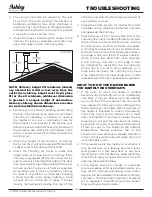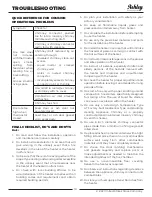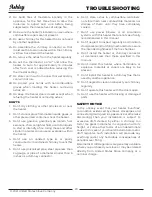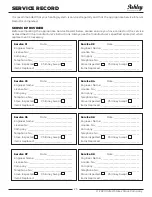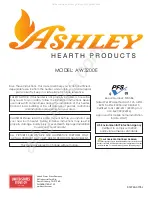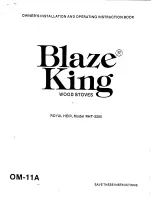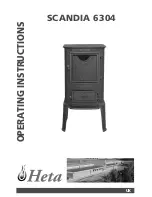
10
© 2021 United States Stove Company
CAUTION:
THE HEATER MUST BE PLACED ON A LISTED
FLOOR PROTECTOR AS NOTED IN THIS
MANUAL IF THE FLOOR IS WOOD OR OTHER
COMBUSTIBLE FLOORING. IF CARPET IS
PRESENT, IT MUST BE REMOVED. THE FLOOR
PROTECTOR MUST NOT BE PLACED ON
CARPET.
CAUTION:
MOST WALLS AND CEILINGS CONTAIN
WOOD EVEN THOUGH THEY ARE MADE OF
SHEETROCK OR PLASTER ON THE OUTSIDE.
THESE WALLS AND CEILINGS CAN CATCH
FIRE FROM THE HOT HEATER OR CHIMNEY
CONNECTOR IF THE HEATER AND CHIMNEY
CONNECTOR ARE NOT PROPERLY INSTALLED.
MINIMUM CLEARANCE TO
COMBUSTIBLE WALLS AND CEILINGS
Minimum clearances to unprotected combustible
walls and ceilings as noted in this manual must be
maintained. Drapes, curtains, furniture and other
combustible materials should be kept much further
away from the heater to avoid a fire. If you chose to,
you may install the heater and chimney connector
closer to combustible surfaces than indicated in
this manual if a clearance reduction system is also
installed to protect combustible ceiling and wall
near the heater and chimney connector. However,
there are limits as to how close the heater and
chimney connector can be installed to combustible
surfaces protected by a clearance reductions
system. A correctly installed clearance reduction
system protects the combustible surfaces well
beyond the sides and above the top of the heater and
beyond the sides and top of the chimney connector
pipe. Two common types of clearance reductions
systems use sheet metal with a thickness of 28
gauge (galvanized steel, aluminum, copper) or a
3-1/2 inch (4 inch thick nominal) thick masonry wall.
Either of these materials must be spaced out 1 inch
from the combustible surfaces. With sheet metal,
noncombustible spacers are used to maintain
the 1 inch air space. With a masonry wall, metal
wall ties and furring strips, if needed, are used to
anchor the brick to the wall. To avoid excessive heat
transmission, the spacers or wall ties should not
be placed directly behind the heater or chimney
connector. The 1 inch air space provides free air
circulation. It is essential that there be openings at
the top and bottom of these clearance reducers so
cool air can enter at the bottom and warm air exit at
the top. It is the “chimney effect” whereby when the
air in the space is heated, it rises exiting from the
top and being replaced by cooler air at the bottom,
that makes these shields effective. Masonry, or
other noncombustible products, attached directly
to a combustible surface without an air space offer
very little protection and cannot be considered a
clearance reduction system unless specific materials
have been tested and listed for direct attachment
to a combustible surface. The same applies to thin
veneer brick and stone coverings. These materials
provide adequate protection only when mounted
on sheet metal with a 1 inch minimum spacing to the
wall. A variety of prefabricated clearance reduction
systems which have been safety tested and listed
are available through heater dealers. Always look
for a safety listing label on the product when
selecting a clearance reduction system through a
heater dealer and make sure it is designed for use
with solid fuel. The manufacturers of these tested
and listed systems provide specific installation
instructions that must be followed exactly for a safe
installation. Should you chose to make your own
clearance reduction system, contact your local fire
department, fire marshal or building code inspector
for specific requirements regarding home-
constructed clearance reduction systems and safe
installation clearances to protected combustible
surfaces.
TO SAFELY AND PROPERLY INSTALL
THIS HEATER
1. Install a Listed High Temperature Type HT
Factory-built Residential Type and Building
Heating Appliance Chimney, build a masonry
chimney or adapt an existing chimney to vent
the heater. (See the Chimney Connector and
Chimneys section of this manual for important
information).
2. Purchase the 6-inch diameter chimney
connector pipes that are required. The pipe
should be black or blued steel, 24 gauge
minimum. If elbows are needed, use only
seamless elbows because seamed elbows can
leak smoke. Do not use more that two elbows
or the chimney draft will be restricted (See the
Chimney Connector and Chimneys section of
this manual for details). Number 8 sheet metal
screws and furnace cement will also be needed
INSTALLATION


















